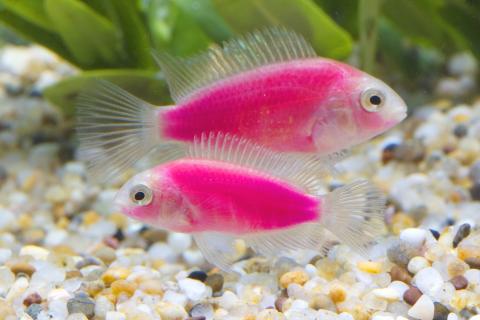|
Taiwanese engineer
first florescent pink angelfish
NEW BREED: Researchers from Jy Lin Trading,
National Ocean University and Academia Sinica developed the fish, and were
immediately offered NT$100,000 for one
By Chung Li-hua and Jake Chung / Staff reporter, with staff
writer

The world’s first pink angelfish,
jointly developed by researchers from the Academia Sinica and Jy Lin Trading,
are pictured in Taipei on Wednesday.
Photo: Chung Li-hwa, Taipei Times
The world’s first-ever pink florescent
Pterophyllum scalare, commonly known as the angelfish, were showcased in an
exhibit on Wednesday prior to the Taiwan International Aquarium Expo, which
opens today.
Lin Yu-ho (林育禾), president of Jy Lin Trading Co — the company that cooperated
with National Ocean University and Academia Sinica on developing the fish — said
this was the first time the world had seen a pink angelfish since the fish was
discovered in the Amazon.
Despite the 32 colors developed worldwide for the angelfish, the fish lacked the
cells to create any color resembling pink, Lin said, adding that the company had
accomplished the endeavor after three years of research with the university and
Academia Sinica.
Lin said the florescent proteins that would be able to display a “pinkish” color
were discovered by National Kaohsiung Marine University associate professor Chen
Ming-chyuan (陳鳴泉) on acropora corals growing near Taiwan.
National Ocean University assistant professor Gong Hong-yi (龔紘毅) discovered that
the fish would be born pink if micro-transfusion methods were used to transfuse
the protein into angelfish eggs.
The research group at Academia Sinica, which consisted of researcher Wu Chin-lieh
(吳金洌) and associate research fellow Chen Chih-yi (陳志毅), collaborated to inject
the proteins into the eggs.
The research team said that the micro-transfusion process had been very
difficult due to the fragility of the angelfish eggs, adding that on average
they had been able to successfully transfuse the proteins into only one egg per
10,000 at first.
The team said they were able to raise the success rate to 1 percent after three
years of research.
Despite the first appearance causing quite an uproar, with one foreign buyer
even offering NT$100,000 for one of the genetically modified fish, the company
was forced to decline until the species passes safety assessments in field
tests.
Jy Lin general manager Ou Mei-ju (歐梅如) said the only florescent fish currently
on the market is the zebrafish, which mostly features green and pink colors.
However, Ou said the florescent colors of the zebrafish can only be observed at
night, while the florescent lighting of the company’s angelfish can be seen even
in broad daylight.
Additional reporting by Chen Yi-ching and Yu Chao-fu
|
![]()
![]()
![]()